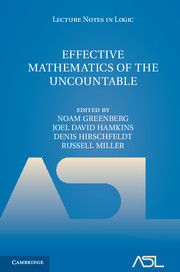Book contents
- Frontmatter
- Contents
- Preface
- Introduction
- Some results on ℝ-computable structures
- Infinite time Turing machines and an application to the hierarchy of equivalence relations on the reals
- Computable structure theory using admissible recursion theory on ω1 using admissibility
- Local computability and uncountable structures
- Borel structures: a brief survey
- E-recursive intuitions
- Reverse mathematics, countable and uncountable: a computational approach
- Effective model theory: approach via σ-definability
- References
Some results on ℝ-computable structures
Published online by Cambridge University Press: 05 December 2013
- Frontmatter
- Contents
- Preface
- Introduction
- Some results on ℝ-computable structures
- Infinite time Turing machines and an application to the hierarchy of equivalence relations on the reals
- Computable structure theory using admissible recursion theory on ω1 using admissibility
- Local computability and uncountable structures
- Borel structures: a brief survey
- E-recursive intuitions
- Reverse mathematics, countable and uncountable: a computational approach
- Effective model theory: approach via σ-definability
- References
Summary
§1. Introduction. The theory of effectiveness properties on countable structures whose atomic diagrams are Turing computable is well-studied (see, for instance, [1, 15]). Typical results describe which structures in various classes are computable (or have isomorphic copies that are) [19], or the potential degree of unsolvability of various definable subsets of the structure [16]. The goal of the present paper is to survey some initial results investigating similar concerns on structures which are effective in a different sense.
A rather severe limitation of the Turing model of computability is its traditional restriction to the countable. Of course, many successful generalizations have been made (see, for instance, [28, 12, 13, 23, 24, 26] and the other chapters in the present volume). The generalization that will be treated here is based on the observation that while there is obviously no Turing machine for addition and multiplication of real numbers, there is strong intuition that these operations are “computable.” The BSS model of computation, first introduced in [5], approximately takes this to be the definition of computation on a given ring (a more formal definition is forthcoming). This allows several problems of computation in numerical analysis and continuous geometry to be treated rigorously. The monograph [4] gives the examples of the “decision problem” of the points for which Newton's method will converge to a root, and determining whether a given point is in the Mandelbrot set.
- Type
- Chapter
- Information
- Effective Mathematics of the Uncountable , pp. 14 - 32Publisher: Cambridge University PressPrint publication year: 2013

